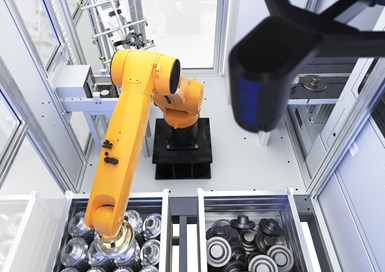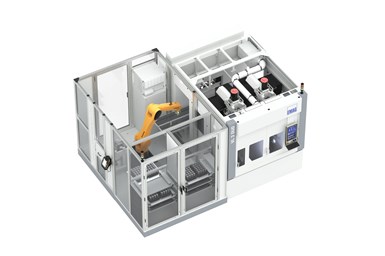
The desired batch sizes in a given period of time are taken into account in the development of the robot solution. (Photo credits: Emag)
Production solutions using robotic automation are on the rise. With robotic assistance, a fast and unattended flow of parts can be established within a machine shop, reducing unit production costs and increasing production reliability and quality.
To that end, Emag links its vertical turning pick-up machine technology with highly individual robot solutions designed within the requirements of the workpiece and the production process.
Featured Content
“Overall, it is safe to say that more and more robotic solutions are being used on our machines,” explains Jürgen Maier, Emag head of business unit turning. “After all, we have a large number of machines that already have internal automation based on pick-up technology. Consequently, we can integrate these solutions via robots into integrated production systems relatively easily and establish a smooth flow of parts at a single location.
“The focus is always on the requirements of the workpiece and the associated production process,” he continues. “Decisive questions here are, for example, what batch sizes are to be produced in a given period of time and how autonomously the solution should operate. In any case, we are very flexible and adapt in many ways to the existing production environment or space conditions.”

In bin picking systems, the workpieces are in random positions. With the help of a 3D sensor system, the robot not only picks the components, but also correctly recognizes and aligns them and feeds them to the next processing step.
Automated part-feeding options include using infeed/outfeed conveyor belts, palletizers, drawers or bin picking. With the help of these systems, the robot “operates” itself when it picks up or finishes placing new components. That said, each solution has different strengths.
For example, belt or hinge conveyors can be a good option when the flow of parts needs to be smooth from an upstream production solution to the machine tool. The robot can then simply pick up the components from the belt and deposit them again later, with the belts arranged in different configurations depending on the space situation or the desired part flow. Pneumatic stoppers ensure that the components are separated, and it is also possible to detect the workpiece alignment on the belt using a camera.
A highly flexible alternative to this are bin picking systems. Here, the workpieces in a bin are positioned randomly, and the robot arm not only picks the components with the aid of a 3D sensor system, but also correctly recognizes, aligns and feeds them to the next processing step. The system can be used flexibly and configured for many applications.
In contrast, the use of palletizers presupposes an “orderly” start. In this case, the system is loaded and unloaded via a blister cart, for example. It contains boxes stacked on top of each other with corresponding mold nests containing the components (a relatively large quantity per cart, which an operator simply pushes into a defined position from which the robot can access). The cart with finished parts is in a different position.
“One of the things that matters in this kind of solution is that you relate the cycle time of the Emag machine and the desired man-hours at the machine,” Maier says. “So if the machining cycle within the machine is only a few seconds and at the same time you are aiming for minimum operator effort at the machine, this solution might not be suitable because the carriages would then have to be replaced too frequently. But these are precisely the calculations that we carry out for every robot solution and advise the customer accordingly.”
A drawer system is an alternate variant. The workpieces are located in pneumatically movable drawers, which are quickly loaded by blister systems. In this case, three of these drawers are arranged one above the other in a cabinet, allowing a larger number of pieces to be stacked and processed (without intermediate operator intervention) often in a small footprint. Incidentally, loading and unloading of the drawers takes place without interrupting the process — the robot simply continues to work on a compartmentalized drawer.

With the drawer system, the workpieces are provided to the robot on different levels. While the drawers are being loaded, the robot in the cell supplies the machine with workpieces.
Regardless of the robotic automation process, Emag offers a range of additional options that can be applied to each type of robotic part-handling system. For example, it is possible to integrate statistical process control (SPC) including a measuring station. Here, individual components are regularly ejected, measured and reintroduced for quality assurance. It is also possible to place optical control systems with cameras, a gripper station for processing a wide range of workpieces, small washing and cleaning stations, deburring systems and laser or engraving stations within the robot cell. The respective solution is then also controlled by the robot. The result is a continuous flow of parts across different technologies.
Emag uses computer-based simulations when planning automation cells to check factors such as cycle time, robot accessibility, material flow in large production lines and more. Virtual commissioning — that is, testing planning data on a virtual machine — is similarly important. In this way, unforeseen errors can be detected and eliminated at an early stage of development. What’s more, actual commissioning is faster later on.
RELATED CONTENT
-
The Evolution of the Y Axis on Turn-Mill Machines
Introduced to the turn-mill machine tool design in about 1996, the Y axis was first used on a single-spindle, mill-turn lathe with a subspindle. The idea of a Y axis on a CNC originated from the quality limitation of polar interpolation and the difficulty in programming, not from electronic advances in controls or servomotor technology as one might commonly think.
-
A New Approach to CNC Turning
This turning process takes advantage of a turn-mill’s B-axis spindle to vary a tool’s approach angle to optimize chip control and feed rates.
-
New Line of Swiss-Types for Job Shops Eyeing High-Production Work
Mazak now offers the Syncrex line of Swiss-type CNC lathes — its first — targeting machine shops getting into higher volume production of complex parts.
.jpg;maxWidth=970;quality=90)





.jpg;maxWidth=970;quality=90)